The red aglaonema plant is a broadleaved tropical houseplant with large green, red, and pink leaves. This flowering Chinese evergreen cultivar belongs to the aglaonema genus. It is easy to grow and maintain regardless of an individual experience.
Types of red aglaonema plants are siam aurora, red anjamani, lady valentine, two-tone moonstone, and a super red star. Pink aglaonema varieties include golden passion, pink splash, peacock, sparkling Sarah, and emerald holiday.
The information in this article provides a detailed description of red aglaonema varieties with names and pictures. Continue reading to learn how to care for a red aglaonema and choose the type that suits your interior space.
You May Also Like: 20 Beautiful Aglaonema Varieties with Names and Pictures
What Does a Red or Pink Aglaonema Looks Like?
Aglaonema plants with red or pink leaves are tropical evergreen perennial hails from the Southeast Asia rainforest. These tropical plants belong to the Aglaonema genus.
Red or pink aglaonema plants have heart-shaped leaves that can reach 4-12 inches long and 2-5 inches wide. These colorful foliages grow alternately on the striking stems.
The foliages have pink and red colors that contrast with a dark green coloration. Some Chinese evergreen varieties have shiny green leaves with pink speckles.
Other red aglaonema varieties have broad dark green leaves with dark red veins. Siam Aurora is my favorite aglaonema species due to its olive green pointed leaves with pinkish-red margins.
Red and pink aglaonema plants are toxic to cats, dogs, and humans. It can cause oral irritation and drool after consumption. (Source: ASPCA).
Keep the houseplant away from the kid since the sap causes skin irritation and dermatitis. The red Chinese evergreen does not cause serious issues with the ultimate care routine.
According to Feng Sui, the red aglaonema species belong to the plants that bring good luck. It also helps to purify the air by removing toxic chemicals at home. (Source: NCBI).
How to Care for Red or Pink Aglaonema Plants
Light Requirements
Red or pink aglaonema plants prefer bright indirect sunlight to thrive well. But these aglaonema varieties can also adapt to low light conditions.
Direct sunlight exposure can cause leaf scorching and drooping. It would be best to keep the plant near the window with curtains to reduce sunlight intensity.
These aglaonema species can also tolerate low light conditions, but they will lose some coloration and become leggy in the long run.
Use artificial grow lights (Check Best Deals on Amazon) when the houseplant is located in a dark room. Keep rotating the plant to ensure it gets light on all sides and grows evenly.
Watering Needs
Pink aglaonema varieties do best in consistently moist soil that never gets soggy. An inappropriate watering routine might routine the plant health.
Inspect the soil moisture content before watering your pink or red aglaonema plant. Insert the index finger in 2-3 inches of topsoil and water if it is dry.
Soak the soil until the excess water drain through the drainage holes. Too much soil moisture will cause root rot and even kill the plant.
I recommend watering the houseplant more often during spring and summer. Reduce the watering frequency in winter and fall due to slow growth rate.
Temperature Range
The red aglaonema plants hail from the tropical and subtropical rainforest of Asia. The plant thrives in a warm and humid environment.
Pink or red Chinese evergreen plants prefer a temperature range of 60-70oF. Any temperature below 60oF will trigger dormancy and even ruin the foliages.
I recommend keeping these plants away from cold and hot drafts. Besides that, avoid sudden indoor temperature changes to keep the houseplant healthy and happy.
Humidity Requirements
All aglaonema types are native to the tropical and subtropical regions in Asia. These plants prefer high humidity to thrive well.
Red or pink aglaonema plants can tolerate low humidity. It is one of the reasons behind being suitable for indoor space. Low humidity can result in brown leaf tips and edges.
Relocate the houseplant to the bathroom with adequate light. The frequent use of water will help to increase the humidity level around the plant.
Another excellent option is to use an electric humidifier (Check the Best Deal on Amazon) to boost indoor humidity. Use a hygrometer to detect indoor humidity fluctuation.
Fertilizer Application
Red or pink aglaonema types are light-feeders. Use liquid fertilizer to feed your aglaonemas every month during spring and summer.
Do not apply fertilizer to your houseplants during fall and winter. It is the period where aglaonemas experience a slow growth rate and dormancy.
Be sure to flush the potting soil every three months to avoid salt buildup. Another excellent option is to use homemade fertilizer rather than the commercial counterpart.
It would be best to read my guide on How to Make Homemade Fertilizer for Houseplants. I recommend organic fertilizer to reduce the need for frequent flushing.
Red and Pink Aglaonema Varieties with Names and Pictures
Aglaonema Siam Aurora

It is the most beautiful red aglaonema with red and green foliages. The large heart-shaped leaves are mostly green with red margins.
Some Siam Aurora cultivars have pinkish-red leaves with speckles of olive-green patterns. Siam Aurora thrives in medium indirect sunlight.
Bright indirect sunlight will keep the pink and red colorations on the Chinese evergreen more vibrant. It can also tolerate low light conditions for a short period.
Avoid growing siam aurora in soggy potting soil. I recommend sticking to an appropriate watering routine to enhance a healthy growth rate.
Red Anjamani Aglaonema
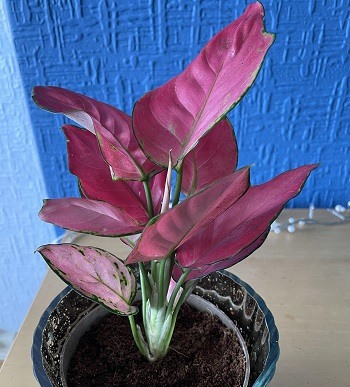
The red anjamani aglaonema has deep red heart-shaped leaves with thin green margins. The faint green veins enable the houseplant to create a lasting impression.
Red anjamani is the most famous choice due to its bright red foliages and spotted dark green markings with compact size. The aglaonema cultivar maintains its vibrant colors throughout.
The red Chinese evergreen is suitable for tabletop, bright windowsills, and office desks. It can also tolerate low light but may develop more green coloration on the red leaves.
Lady Valentine Aglaonema
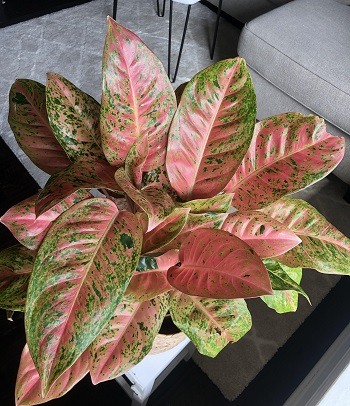
The lady valentine aglaonema has oval to lanceolate red, pink, and green leaves. The dark green markings along the edges and veins create a lasting impression.
The aglaonema cultivar may either have pink and green leaves or bright red with lime green leaves on some plants. Keep the red aglaonema in a location with bright indirect sunlight.
Super Red Star Aglaonema
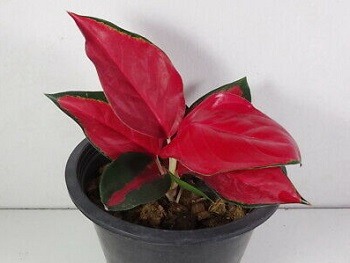
The super red star has spectacular bright red glossy foliages with some hints of green along the margins and tips. The sheen reflects the natural or artificial light to create an exotic feeling.
The red aglaonema leaves are variegation that develops with time. Juvenile leaves may appear dark green with red blotches across the midrib.
Two-Tone Moonstone Aglaonema
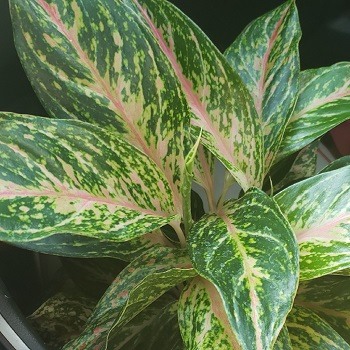
It is a colorful aglaonema species with light pink and green foliages. The pointed leaves grow as a large clump of bright foliages.
The green leaves have pink central ribs and masses of pink speckles. The bright pink stems and ability to purify the air is the reason behind their high demand.
Emerald Holiday Aglaonema
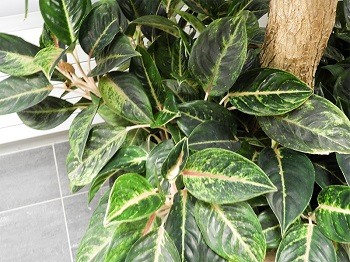
The aglaonema plant has elongated lance-shaped green leaves with pink or red veins. It also has pink stems and veins that give the plant an adorable appearance.
Emerald holiday is an ideal aglaonema cultivar for dark rooms due to its dark green leaves. The clumping compact growth makes this red aglaonema suitable for pots.
Sparkling Sarah Aglaonema
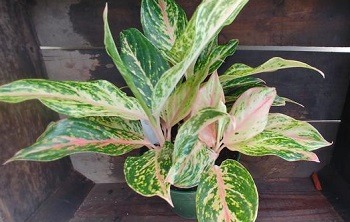
Sparkling Sarah is an exotic red aglaonema cultivar with green, pink, and yellow variegation plants. The shiny lime green rounded ovate leaves have pink speckles on veins and midribs.
The pink splashes could cover the green leaves depending on the lighting condition. The bright pink splashes contrast perfectly with the yellow and green tropical leaves.
The sparkling Sarah aglaonema is a perfect choice for homes and offices. Thanks to its compact size and ability to tolerate low-light conditions.
Golden Passion Aglaonema
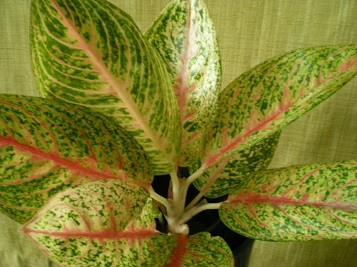
The golden passion red aglaonema has oblong-ovate light green leaves with pink midribs and veins. The yellow variegation makes this aglaonema cultivar the popular choice.
The golden passion also has dark pink leaf undersides and bright-colored pink stems. Juvenile leaves look like a pink tube before unfurling.
Red Peacock Aglaonema
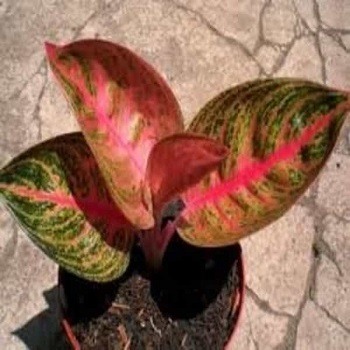
A red peacock aglaonema plant has broad leaves with pink, green, and yellow variegations. It has the broadest leaves when compared to other cultivars.
The colorful leaves have lime green blades with bright pink veins arching from the central midrib. The creamy-yellow speckles and splashes on leaves make a lasting impression.
Pink Splash Aglaonema
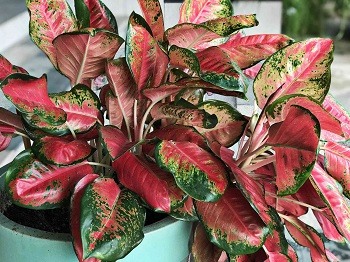
Pink splash is a compact and bushy red aglaonema cultivar with pink and green leaves. It also has broad and glossy green pointed leaves with pink splashes.
The amount of light will determine the pink variegation on the leaves. The pink colors may range from pale pink to dusty pink and dark pink.
Super Pink Aglaonema
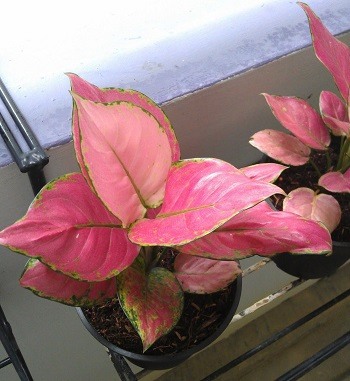
The tropical super pink plant is another stunning pink aglaonema type. The pointed lance-shaped leaves are almost pink with some dark green specks.
Super pink aglaonema is among the rare red aglaonema varieties. The compact growth makes it ideal for adding visual interests that complement the indoor décor.
Potted pink aglaonema is a perfect choice for tabletops, desktops, and bright windowsills. Keep the aglaonema cultivar away from bright direct sunlight.
You May Also Enjoy: How to Grow and Care for Chinese Evergreen
